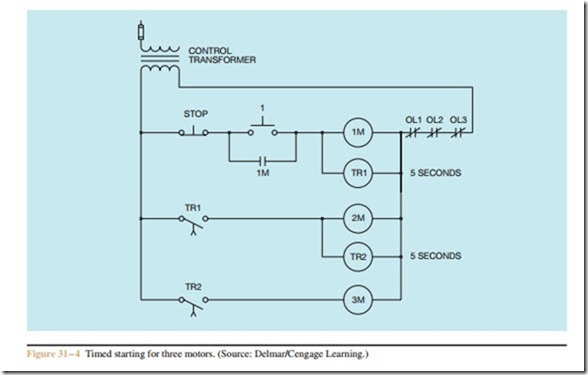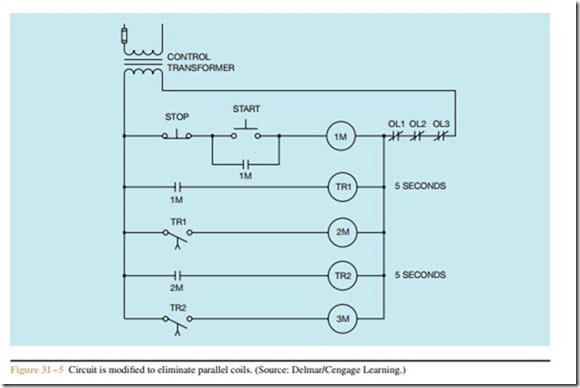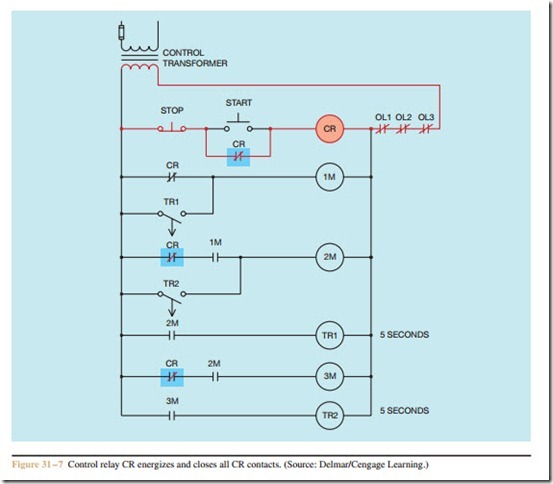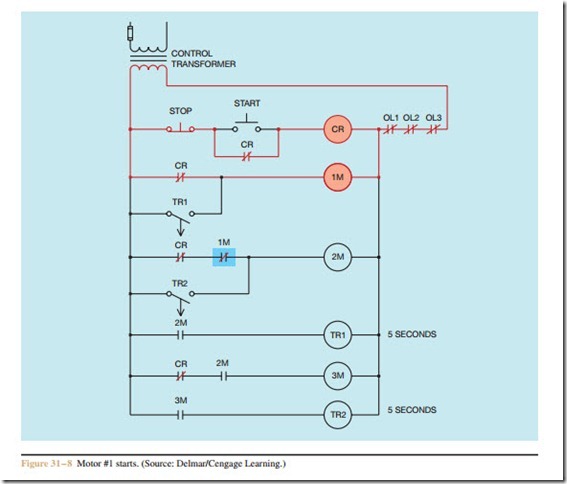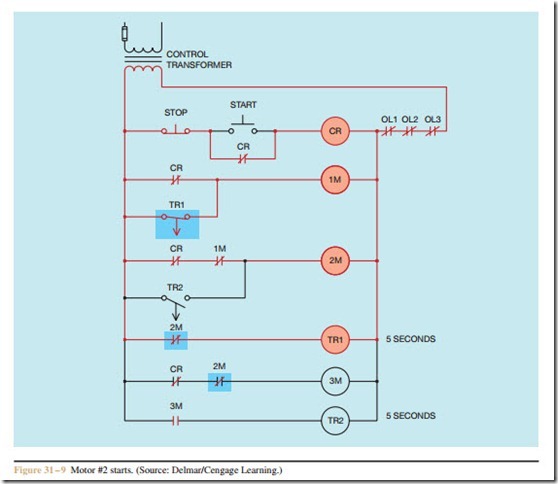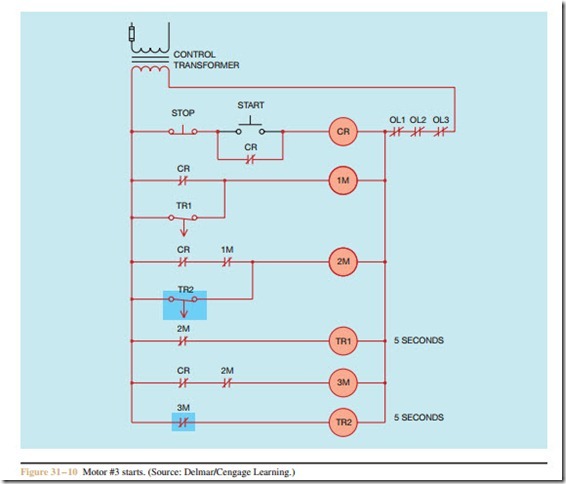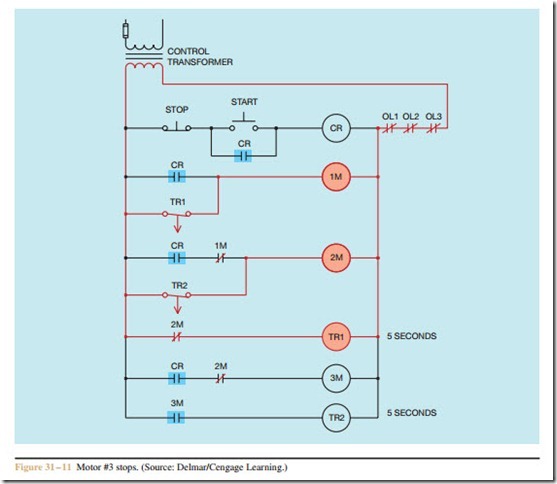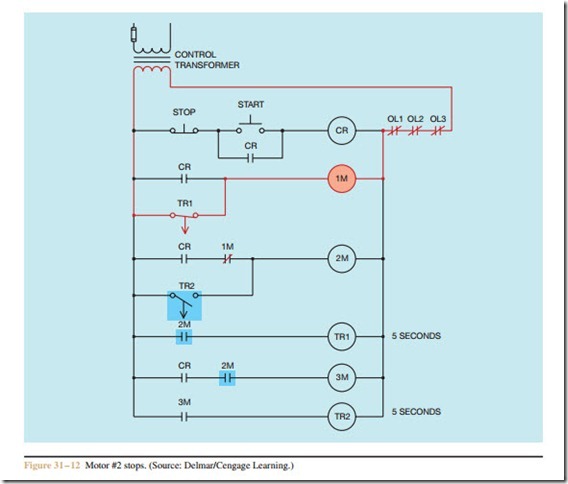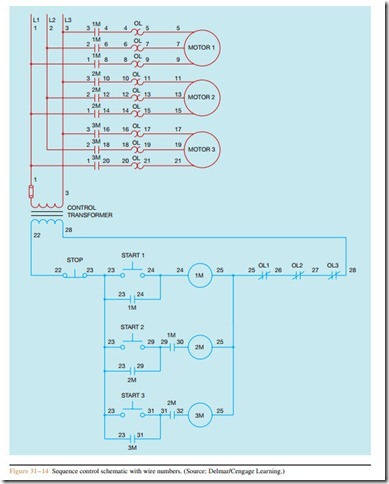Automatic Sequence Control
Circuits that permit the automatic starting of motors in sequence are common. There are a number of methods that can be employed to determine when the next motor should start. Some circuits sense motor current. When the current of a motor drops to a predetermined level, it will permit the next motor to start. Other circuits sense the speed of one motor before permitting the next one to start. One of the most common methods is time delay. The circuit shown in Figure 31 – 4 will permit three motors to start in sequence. Motor #1 will start immediately when the start button is pressed. Mo- tor #2 will start five seconds after motor #1 starts, and motor #3 will start five seconds after motor #2 starts. Timer coil TR1 is connected in parallel with 1M starter coil. Since they are connected in parallel, they will en- ergize at the same time. After a delay of 5 seconds, TR1 contact will close and energize coils 2M and TR2. Mo- tor #2 will start immediately, but timed contact TR2 will delay closing for 5 seconds. After the delay period, starter coil 3M will energize and start motor #3. When the STOP button is pushed, all motors will stop at virtually the same time.
Although the circuit logic in Figure 31 – 4 is correct, most ladder diagrams do not show coils connected in parallel. A modification of the circuit is shown in Figure 31 – 5. In this circuit, auxiliary contacts on the motor starters are used to control the action of the timed relays. Note that the logic of the circuit is identical to that of the circuit in Figure 31 – 4.
Stopping the Motors in Sequence
Some circuit requirements may demand that the motors turn off in sequence instead of turning on in sequence. This circuit will require the use of off-delay timers. Also, a control relay with four contacts will be needed. The circuit shown in Figure 31 – 6 will permit the motors to start in sequence from one to three when the START button is pressed. Although they start in sequence, the action will be so fast that it will appear they all start at approximately the same time. When the STOP button is pressed, however, they will stop in sequence from three to one with a time delay of 5 seconds between each motor. Motor #3 will stop immediately. Five seconds later motor #2 will
stop, and five seconds after motor #2 stops, motor #1 will stop. An overload on any motor will stop all motors immediately.
Circuit Operation
When the START push button is pressed, control relay CR energizes and causes all CR contacts to close, Figure 31 – 7. Motor starter 2M cannot energize because of the normally open 1M contact connected in series with coil 2M, and motor starter 3M cannot energize because of the normally open 2M contact connected in series with coil 3M. Motor starter 1M does energize, starting motor #1 and closing all 1M contacts, Figure 31 – 8.
The 1M contact connected in series with coil 2M closes and energizes coil 2M, Figure 31 – 9. This causes motor #2 to start and all 2M contacts to close. Off- delay timer TR1 energizes and immediately closes the TR1 contact connected in parallel with the CR contact that is connected in series with coil 1M.
When the 2M contact connected in series with coil 3M closes, starter coil 3M energizes and starts motor #3. The 3M auxiliary contact connected in series with off-delay timer coil TR2 closes and energizes the timer, causing timed contacts TR2 to close immediately, Figure 31 – 10. Although this process seems long when discussed in step-by-step order, it actually takes place almost instantly.
When the STOP button is pressed, all CR contacts open immediately, Figure 31 – 11. Motor #1 continues to run because the now closed TR1 contact maintains a circuit to the coil of 1M starter. Motor #2 continues to run because of the now closed TR2 contact. Motor #3, however stops immediately when the CR contact connected in series with coil 3M opens. This causes the 3M auxiliary contact connected in series with TR2 coil to open and de-energize the timer. Since TR2 is an off-delay timer, the timing process starts when the coil is de-energized. TR2 contact will remain closed for a period of 5 seconds before it opens.
When TR2 contact opens, coil 2M de-energizes and stops motor #2. When the 2M auxiliary contacts open, TR1 coil de-energizes and starts the time delay for contact TR1, Figure 31 – 12. After a delay of 5 seconds, timed contact TR1 opens and de-energizes coil
1M, stopping motor #1 and opening the 1M auxiliary contact connected in series with coil 2M. The circuit is now back in its normal de-energized state, as shown in Figure 31 – 6.
Timed Starting and Stopping of Three Motors
The addition of two timers make it possible to start the motors in sequence from 1 to 3 with a time delay between the starting of each motor, as well as stopping the motors in sequence from 3 to 1 with a time delay between the stopping of each motor. The circuit shown in Figure 31 – 13 makes this amendment. When the START button is pressed, all CR contacts close. Motor #1 starts immediately when starter 1M energizes. The 1M auxiliary contact closes and energizes on-delay timer TR3. After 5 seconds, starter 2M energizes and starts motor #2. The 2M auxiliary contact connected in series with off-delay timer TR1 closes, causing timed contact TR1 to close immediately. The second 2M auxiliary contact connected in series with on-delay timer TR4 closes and starts the timing process. After 5 seconds, timed contact TR4 closes and energizes starter coil 3M, starting motor #3. The 3M auxiliary
contact connected in series with off-delay timer TR2 closes and energizes the timer. Timed contact TR2 closes immediately. All motors are now running.
When the STOP button is pressed, all CR contacts open immediately. This de-energizes starter 3M, stop- ping motor #3 and de-energizing off-delay timer coil TR2. After a delay of 5 seconds, timed contact TR2 opens and de-energizes starter 2M. This causes motor #2 to stop, off-delay timer TR1 to de-energize, and on- delay timer TR4 to de-energize. TR4 contact reopens immediately. After a delay of 5 seconds, timed contact TR1 opens and de-energizes starter coil 1M. This causes motor #1 to stop and on-delay timer TR3 to de- energize. Contact TR3 reopens immediately and the circuit is back in its original de-energized state.
Review Questions
1. What is the purpose of sequence control?
2. Refer to the schematic diagram in Figure 31 – 14.
Assume that the 1M contact located between wire numbers 29 and 30 had been connected normally closed instead of normally open. How would this circuit operate?
3. Assume that all three motors shown in Figure 31 – 14 are running. Now assume that the stop button is pressed and motors #1 and #2 stop running, but motor #3 continues to operate. Which of the follow- ing could cause this problem?
a. Stop button is shorted.
b. 2M contact between wire numbers 31 and 32 is hung closed.
c. The 3M load contacts are welded shut.
d. The normally open 3M contact between wire numbers 23 and 31 is hung closed.
4. Referring to Figure 31 – 14, assume that the normally open 2M contact located between wire
numbers 23 and 29 is welded closed. Also assume that none of the motors are running. What would happen if:
a. The number 2 push button were pressed before the number 1 push-button?
b. The number 1 push button were pressed first?
5. In the control circuit shown in Figure 31 – 2, if an overload occurs on any motor, all three motors will stop running. Using a separate sheet of paper, re- design the circuit so that the motors must still start in sequence from 1 to 3, but an overload on any motor will stop only that motor. If an overload should occur on motor #1, for example, motors #2 and #3 would continue to operate.
